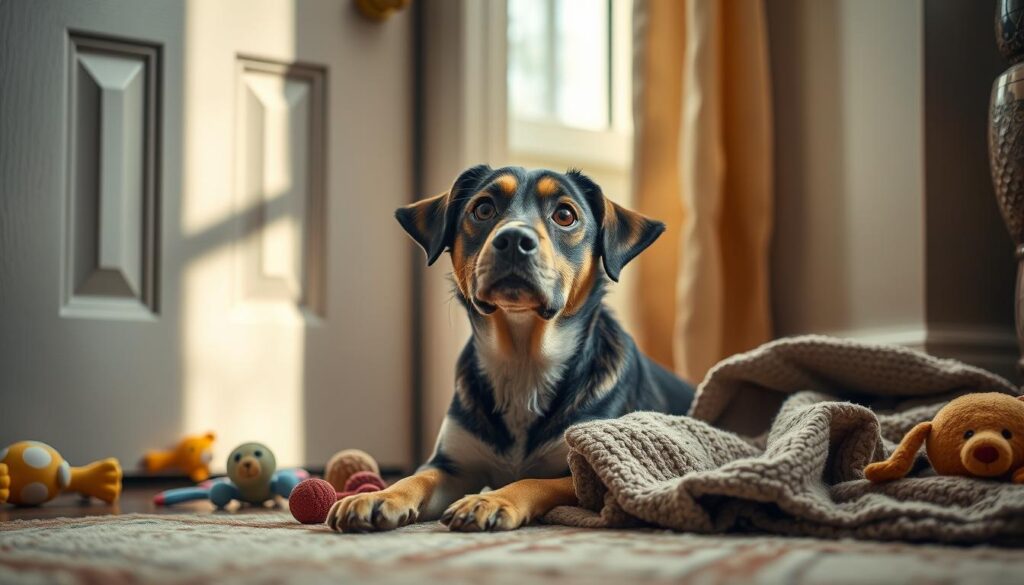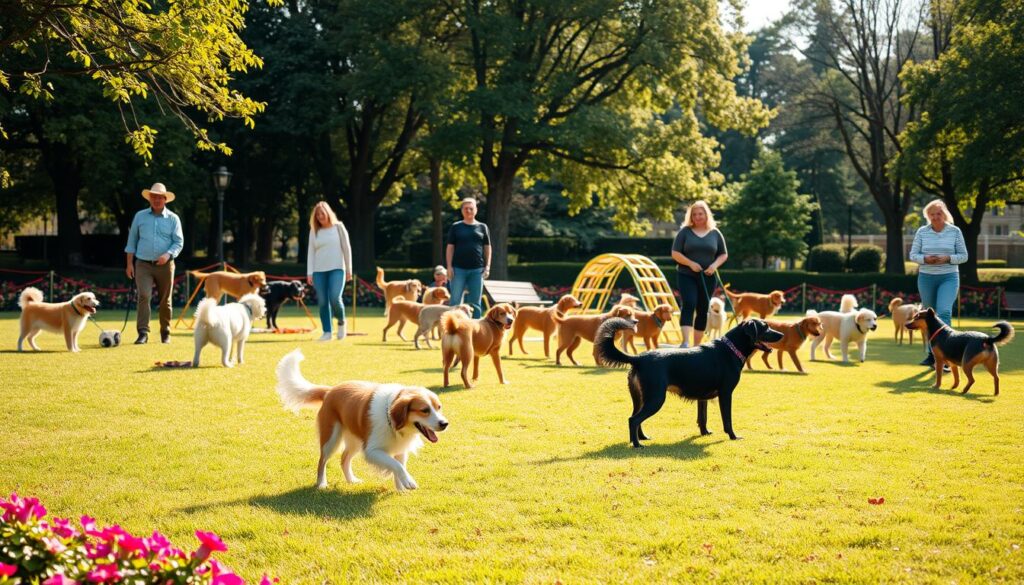Physical Address
304 North Cardinal St.
Dorchester Center, MA 02124
Physical Address
304 North Cardinal St.
Dorchester Center, MA 02124

Ever wondered why some dogs get anxious when left alone? Dealing with dog anxiety is tough for many pet owners. But, with the right help, you can ease your dog’s fear of being apart. Are you ready to learn how to manage separation anxiety in dogs?

Many dogs face separation anxiety, showing signs like urinating, defecating, barking, howling, chewing, digging, and even trying to escape. Knowing what causes it and using the right methods can help. Experts have many ways to help your dog feel calm and confident again.
Separation anxiety is a common issue in dogs. It affects about 20% to 40% of them. This condition shows through distressing behaviors when dogs are left alone or away from their main caregiver.
Signs of separation anxiety include a lot of barking, howling, or whining. Dogs might also have accidents inside, even if they’re well-trained. They might chew, dig, or scratch things, drool, pant, and pace a lot. Some dogs even try to get out of their space.
These behaviors start when the owner is getting ready to leave. They can get worse after the owner is gone.
It’s key to tell separation anxiety apart from other issues like not being house-trained, being bored, or having health problems. Separation anxiety is about the dog’s distress when left alone. Knowing the causes and symptoms helps owners use the right behavior modification and calming techniques for their dogs.
Separation anxiety is a big problem for dogs. Young dogs are more likely to have it than older ones. A study in the Journal of Applied Animal Welfare Science found it’s a top reason dogs are given up by owners.
Many things can cause dog separation anxiety. These include sudden changes, moving, and missing family members. Even scary events like a house robbery can trigger it. Not enough exercise and mental play can make it worse.
It’s interesting that some dogs don’t show signs of anxiety when their owners are around. But, knowing the signs is key to helping them. Vets say dogs shouldn’t be left alone for more than four hours. Puppies should be watched even closer, as they can get anxious quickly.
It’s important to avoid letting dogs “cry it out” as it can harm them. Instead, we should take steps to prevent or treat their anxiety. This can greatly improve their pet separation issues and furry friend wellness.
Dealing with separation anxiety in dogs needs a careful plan. Professional trainers and animal behaviorists use special techniques. They focus on counterconditioning and desensitization.
Counterconditioning makes being alone a positive thing. Dogs get treats or fun toys when left alone. Desensitization slowly gets dogs used to being alone, starting with short times.
If your dog’s anxiety is severe, see a vet or animal behaviorist. They can create a plan just for your dog. They might suggest medication or special training.
Good training and stress management are key for dogs with separation anxiety. With expert help, dogs can learn to handle being alone. This way, they can be happy even when their owners are not there.
Changing your dog’s environment can really help with pet separation issues. A safe and comfy space can ease their anxiety and make them feel better.
Choose a special area or room for your dog. Fill it with their favorite bedding, toys, and scented items. Leaving the radio or TV on can also calm them down.
Use puzzle toys or slow-release treat dispensers to keep your dog busy. These toys are great for their mental health and can calm them down.
Make sure the space is safe to avoid any accidents. Some dogs do well in crates, while others prefer a certain room. Try different options to see what works best for your dog.
Creating a safe and cozy environment is key for managing your dog’s separation anxiety. With these simple changes, you can make your dog feel more relaxed and less stressed when you’re away.
Exercise and mental games are key to managing a dog’s separation anxiety. Daily walks, runs, or playtime can lower stress and anxiety. Training games, fetch, and puzzles keep their mind busy and distracted when you’re away.
Exercising your dog before leaving can make them feel calmer and less anxious. Try to exercise them for at least an hour a day. This mix of physical and mental activities is good for their overall health.
| Dog Training Methods | Pet Owner Guidance | Canine Mental Health |
|---|---|---|
| Positive reinforcement training | Gradual desensitization | Interactive toys and puzzles |
| Behavior modification training | Consistent routine | CBD oil and calming supplements |
| Obedience and agility classes | Professional behavioral support | Exercise and playtime |

Adding different physical and mental activities to your dog’s routine can help with separation anxiety. A tired, mentally active dog is more likely to relax and feel safe when alone. This makes for a happier experience for both you and your pet.
Dealing with separation anxiety in dogs often requires a consistent departure routine. This can help reduce the dog’s distress and anxiety when their owner leaves. By creating a predictable process, pet owners can ease their dog’s transition and minimize the emotional upheaval associated with being left alone.
One key strategy is to keep departures and arrivals low-key. Avoid making a big fuss or showering the dog with attention immediately before leaving or upon returning home. This can inadvertently reinforce the dog’s excitement or anxious behavior. Instead, practice “fake” departures by going through the typical leaving rituals, such as picking up keys or putting on shoes, without actually leaving the house. Gradually increase the duration of these absences to help the dog become more accustomed to being alone.
Pet owners can also use positive reinforcement to create a positive association with the owner’s departure. Provide the dog with a special treat or interactive toy only when you are about to leave. This helps the dog learn that your absence is not a negative experience. Additionally, ignore the dog for the first few minutes upon returning home to avoid rewarding any anxious behaviors.
Establishing a consistent routine and minimizing the drama around departures and arrivals can go a long way in helping dogs with Dealing with Separation Anxiety in Dogs. By implementing these dog behavior modification techniques, pet owner guidance can effectively manage separation anxiety and provide their canine companions with a sense of security and comfort.
Dealing with pet separation issues can be tough. But, there are natural ways to help your furry friend feel better. Try using pheromone diffusers or sprays to reduce anxiety. These products release calming pheromones that make your dog feel more relaxed when alone.
Leaving clothes with your scent around the house can also comfort your dog. Your familiar smell can make them feel secure. Some dogs also find anxiety wraps or thundershirts comforting. These apply gentle pressure, like a hug.
Before trying over-the-counter calming supplements, talk to your vet. Herbs like valerian root, chamomile, and L-tryptophan can calm your dog. Melatonin and L-theanine can also help with anxiety. Remember, every dog is different, so work with your vet to find the right natural solutions.
Comfort items like favorite toys or blankets can also offer reassurance. Keeping a regular routine and providing mental stimulation can make your dog feel more secure and happy.
| Natural Calming Techniques | Potential Benefits |
|---|---|
| Pheromone Diffusers/Sprays | Emit soothing pheromones to reduce anxiety |
| Anxiety Wraps/Thundershirts | Apply gentle pressure to have a calming effect |
| Herbal Supplements (Valerian, Chamomile, L-Tryptophan) | Help manage anxiety and promote relaxation |
| Melatonin and L-Theanine Supplements | Regulate mood and ease anxiety in dogs |
| Comfort Items (Toys, Blankets) | Provide a sense of security and familiarity |

As a new dog owner, it’s important to take steps to prevent separation anxiety. Start by building your dog’s confidence and comfort with being alone early on. This is key to their well-being.
Begin by leaving your dog alone for short periods and gradually increase the time. This teaches them that you’re not gone forever. A consistent routine for feeding, exercise, and alone time also helps ease anxiety.
It’s vital to provide mental and physical stimulation. Engage your dog in training, puzzle toys, and activities that challenge their mind. Regular exercise, like walks and playtime, can help reduce stress. Avoid making a big fuss when you leave or return to prevent reinforcing anxious behaviors.
Consider enrolling your dog in puppy classes or basic obedience training. These environments help build trust and obedience, reducing separation anxiety. Also, teach your dog to be comfortable in different parts of the house for security when you’re away.
By using these prevention strategies, new dog owners can help their pets avoid separation anxiety. With patience, consistency, and focus on their mental and physical health, you can raise a confident, well-adjusted dog.
When dealing with canine stress management and dog anxiety, it’s essential to consult a veterinarian. They can rule out any underlying medical issues that may be contributing to pet separation issues. Conditions like urinary tract infections or hormonal imbalances can sometimes mimic separation anxiety.
Some medications may also make anxiety symptoms worse in dogs. This is why it’s important to talk to a vet.
In severe cases of separation anxiety, vets may prescribe anti-anxiety medications. These include Reconcile (fluoxetine) and Clomicalm (clomipramine). They can take 4-8 weeks to work fully. Short-acting meds like trazodone, clonidine, and alprazolam can help with panic episodes.
Regular check-ups and talking openly with your vet are key to managing separation anxiety in dogs. Your vet can identify medical factors, suggest treatments, and track your pet’s progress. By working together, pet owners and vets can help dogs feel better and stay well.